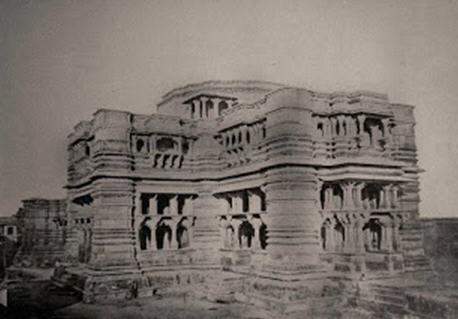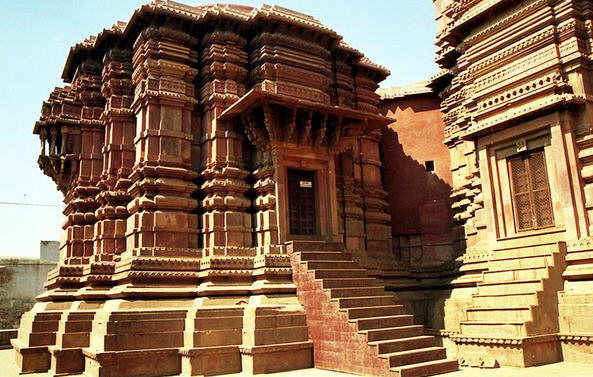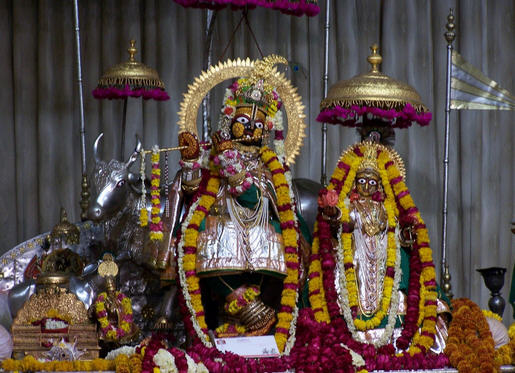
A few minutes walk from Vrinda Kunda is Sri Radha Govindaji temple, built by Maharaja Man Singh, a general from the army of King Akbar. Maharaja Man Singh was a disciple of Raghunath Bhatta Goswami. The temple was a grand seven-story structure, with an altar of marble, silver and gold. Architecturally this temple is one of the finest in North India. A sculptured lotus flower weighing several tons decorates the main hall ceiling. It was said to have cost ten million rupees, and several thousand men were working for five full years to complete it. Akbar himself had donated the red sandstone for its construction. In 1670, during the rule of a later Mughal king, Aurangzeb, it was plundered and destroyed leaving only three stories of the original temple. During this attack, when few stories remained, all of a sudden the ground began to shake violently and Aurangzeb’s men were terrified and ran for their lives, never to return. A replica of Govindaji is worshiped in the new Govindaji Mandir (located behind the original temple). The original Govindaji is worshiped in Jaipur.
Srila Rupa Gosvami originally established this temple under the instruction of Sri Caitanya Mahaprabhu; being ordered to excavate all the lost Holy places of Vrindavan. Five thousand years earlier, Lord Krishna’s grandson, Vajranaba, installed a number of important Deities in Vrindavana; Govindaji was one of these Deities. Rupa Gosvami searched all over Vrindavan to locate the Yogapith, the resting place of the original Deity of Govindaji, but after months of searching, the Deity could not be found.
Feeling disappointed, Rupa Gosvami came and sat by the bank of the Yamuna river and shedding tears, he began to call out the name of Lord Caitanya–“Ha Caitanya, Ha Caitanya” (oh, Caitanya). Suddenly, Lord Krishna, appeared in the guise of a beautiful brijbasi boy. He informed Rupa Gosvami that there was a cow that came every day to a nearby hillock, and the cow emptied its milk into a hole on the hilltop. He asked Rupa to accompany him to the place to see what might be contained in the hole. Rupa Gosvami followed the boy and upon reaching the spot, the boy disappeared.
Looking into the milk drenched hole, Rupa Gosvami immediately fell unconscious in a wave of ecstatic emotions. When he recovered, he summoned the local people who then excavated the hole and found the beautiful Deity of Lord Govinda. The loud cries of “Hey Govinda, He Krishna” suddenly reverberated throughout the sky.
The construction of the temple of Radha Govinda began under the guidance of Raghunatha Bhatta Gosvami and his disciples headed by Raja Man Singh of Jaipur sometime after 1570. It was the most impressive edifice that had ever produced in the whole of Northern India. This temple was originally seven stories tall with a marble altar, silver and gold. A sculptured lotus flower weighing several tons decorates the main hall.
Less than one hundred years later, Emperor Aurangzeb, the Muslim zealot, was standing on the ramparts of his fort at Agra, and noticed a bright light burning in the far distance. Upon being informed that this was a large ghee lamp kept atop the Radha Govinda temple in Vrindavan, he became furious that a Hindu shrine was taller than any Muslim building and immediately ordered its destruction. By the time the soldiers of Aurangzeb arrived, Lord Govindadeva and all the important Deities of Vrindavana had been moved to safer places. The solidiers of Aurangzeb dismantled the top floors of the Govindaji temple.
Because the soldiers of Aurangzeb desecrated the main temple, it is believed that worship cannot continue in that temple. Therefore this temple was established behind the original Govindaji temple and it contains the pratibhu Deities of Radha Govinda. The original Deities of Govinda were brought to Jaipur. The pratibhu Deities are considered to be the same as the originals.

Sri Sri Radha Govinda Temple:
The Deities on the altar in this temple are Govindaji in the middle, to His left is Lord Caitanya, and to His right is Lord Nityananda. Below are small Radha and Krishna Deities. Below Them are Lord Jagannath and a Govardhana-shila.

